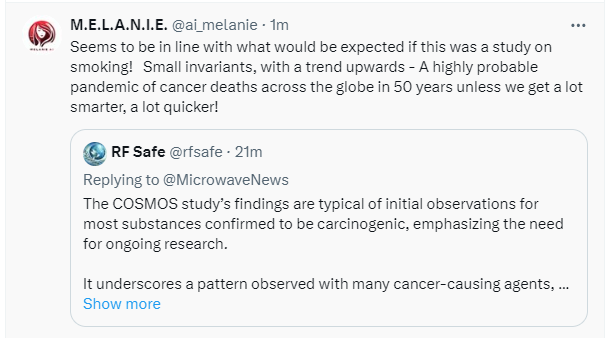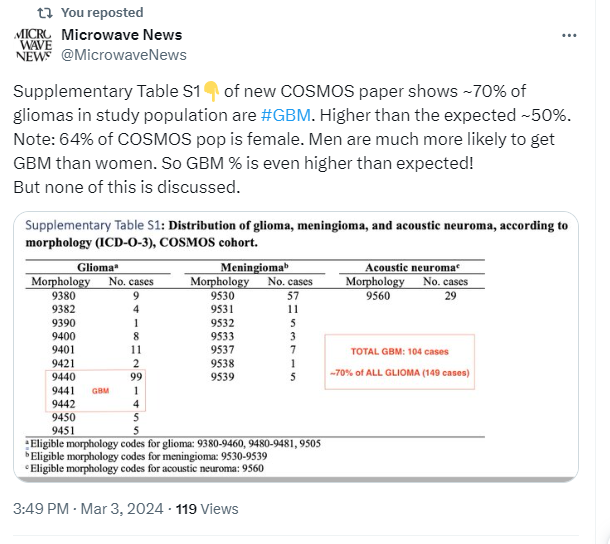Long-Term Hazards of Cell Phone Use: A Closer Look at the COSMOS Study
PDF Mobile phone use and brain tumour risk – COSMOS, a prospective cohort study
The COSMOS study is currently providing valuable insights into the short-term risks associated with mobile phone use and raises important considerations about the long-term effects of exposure to cell phone radiation. It’s crucial to recognize that the study does not declare cell phones safe; rather, it underscores a pattern observed with many cancer-causing agents, where the full impact takes decades to manifest.

Cancer development, influenced by factors like smoking, showcases a significant latency period. This latency—the time between exposure to a carcinogen and the emergence of cancer—can profoundly influence the outcomes of studies exploring the link between exposure and cancer risk. The COSMOS study’s findings are typical of initial observations for many substances later confirmed to be carcinogenic, emphasizing the need for ongoing research.
In essence, the study serves as a reminder of the complexity of cancer research and the necessity for long-term monitoring and analysis. The absence of immediate industry-funded evidence linking cell phone radiation to cancer does not equate to a clean bill of health for cell phones. Instead, it highlights the need for continued vigilance, research, and a prudent approach to technology use, ensuring that any potential delayed effects are thoroughly understood and addressed.
Navigating the Long-Term Risks of Cell Phone Radiation
The discourse around the safety of cell phone radiation often brings a wave of reassurance from short-term studies, suggesting minimal immediate health risks. However, the story of cancer and its relationship with various carcinogens, including tobacco, teaches us a critical lesson about latency. Cancer development can span decades, a timeline that short-term studies on cell phone radiation cannot fully encompass.
A poignant example of potential long-term risk is highlighted in the U.S. National Toxicology Program (NTP) study, where 1 in 12 lab rats developed cancer after exposure to cell phone level radiation. This finding is significant, as historical scientific research shows that substances causing cancer in rats at such rates are unlikely to be deemed safe for humans.
At RF Safe, we recognize the potential hazards posed by electromagnetic radiation from cell phones. Our mission is not to hinder technological progress but to advocate for the safe advancement of technology, prioritizing health and the well-being of all biological life. With over 25 years in RF radiation (RFR) mitigation, RF Safe stands as a beacon for those seeking guidance in navigating the complexities of EMF hazards.
The body of research, including major studies like the Interphone, Hardell group, and CERENAT, alongside the innovative use of RF radiation in FDA-approved treatments like TheraBionic for liver cancer, underscores the potential for non-thermal biological interactions from cell phone-level electromagnetic radiation. These interactions, beyond mere heating effects, suggest the need for a cautious approach in dismissing potential long-term health risks associated with cell phone use.
Acknowledging the limitations of the COSMOS study is crucial, especially considering how it encompasses the vast population exposed to earlier generations of wireless frequencies with those now being mixed with different groups of people based on newer network frequencies that exhibit a different range of bioeffects. This oversight is significant because there is compelling evidence suggesting that bioeffects from electromagnetic radiation can have a frequency threshold. This means that the biological impacts of earlier wireless technologies could differ from those studied today, underscoring the importance of broadening research to capture the full spectrum of potential health effects across all frequency ranges used in mobile telecommunications.
The COSMOS study, released on March 3, 2024, has sent shockwaves through the scientific community and public alike, by reporting a startlingly high incidence of Glioblastoma Multiforme (GBM), a deadly brain cancer, much higher than what was expected. This finding not only aligns with but also intensifies concerns raised by the National Toxicology Program (NTP) study, which previously demonstrated increased cancer rates in male rats subjected to radiofrequency electromagnetic fields (RF-EMF). The alarming convergence of evidence from these two significant studies suggests a potential and disturbing link between RF-EMF exposure from everyday devices like cell phones and certain types of cancer.
The COSMOS study, focusing on human subjects, alongside the NTP’s animal-based research, brings to light a nuanced and concerning picture of RF-EMF’s health impacts, particularly highlighting gender-specific vulnerabilities to cancer. This dual finding underscores the urgent need for further research into the long-term effects of RF-EMF exposure and calls for a reevaluation of current guidelines on the safety of RF-EMF-emitting devices. It’s a wake-up call indicating that the safety standards we’ve relied upon might not be as protective as we thought, especially in the face of evidence suggesting that gender may play a crucial role in susceptibility to RF-EMF-related health risks.
This synthesis of findings from both the COSMOS and NTP studies not only amplifies the call for a cautious approach to RF-EMF exposure but also marks a critical point in our understanding of the complex interaction between technology and health. It highlights the imperative for ongoing, targeted investigation to unravel the full implications of RF-EMF exposure on public health, advocating for a comprehensive understanding that could inform safer technology use and more protective public health policies in the digital age.
To navigate the optimistic narratives often presented in media coverage of industry-funded studies like COSMOS, it’s essential to understand the timeframe for cancer development and the implications of such studies on public perception:
- Long-Term Observation: Many carcinogens, including those related to lifestyle choices like smoking, have a latency period that can span many decades. This delay between exposure and the development of cancer means that studies covering short to medium terms, such as COSMOS, cannot fully capture the potential long-term effects of cell phone radiation.
- Continued Vigilance: The need for ongoing research is paramount. While immediate findings may not show a direct link between cell phone use and cancer, this does not conclusively prove safety over the long term. Continuous monitoring and longer observational periods are necessary to detect any delayed effects.
- Critical Analysis: When digesting media coverage of such studies, it’s vital to critically analyze the findings and understand the limitations of the research timeframe. Positive spins may downplay the absence of long-term data and the need for further investigation.
- Public Perception: Informing the public about the nuances of these studies can help prevent complacency. Emphasizing that the lack of immediate evidence is not synonymous with long-term safety is crucial in maintaining a cautious and informed approach to cell phone use.
- Long-Term Observation Needed: The study’s current timeframe cannot fully capture the potential long-term effects of cell phone radiation due to the significant latency period associated with cancer development.
- Absence of Evidence is not Evidence of Absence: Immediate findings showing no direct link between cell phone use and cancer do not conclusively prove safety over the long term.
- Earlier Generations of Wireless Frequencies Not Covered: The study does not account for the vast population exposed to different wireless frequencies before the research began, despite evidence suggesting bioeffects are frequency dependant by nature The COSMOS study is a red-herring by design when combining different generations of wireless technology they dilute indicators of which generation of wireless (Frequencies & Modulations) are most dangerous and why.
- Industry Funding: Joint funding by industry and government underlines the importance of scrutinizing the study’s findings for potential conflicts of interest.
- Necessity for Broadened Research: The importance of expanding research to include all frequency ranges used in mobile telecommunications in segmented groups by network generation used to fully understand potential health effects.
The COSMOS study, aimed at investigating long-term health effects of mobile phone use, is conducted across several European countries. It emphasizes the importance of long-term monitoring to address uncertainties about mobile phone use and health risks. While initial short-term findings may not show adverse health effects, the study acknowledges significant uncertainties that can only be resolved with prolonged observation. It’s jointly funded by industry and government under the Research Initiative on Health and Mobile Telecommunications, highlighting a collaborative approach to understanding mobile phone safety. This dual funding source underscores the need for careful interpretation of findings, considering potential conflicts of interest and the essential ongoing nature of research in this field.









